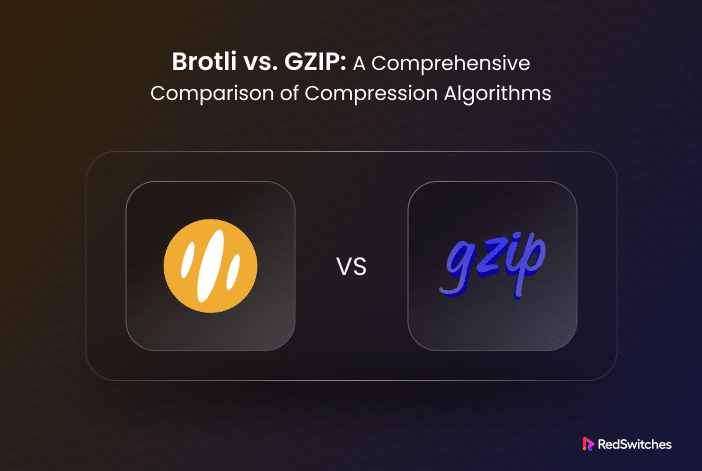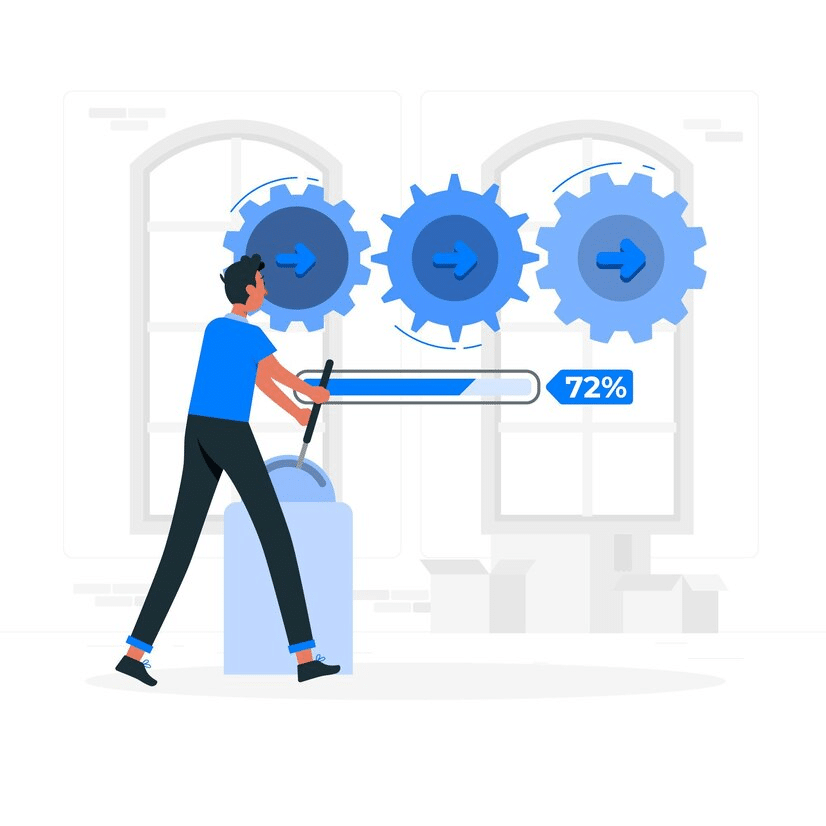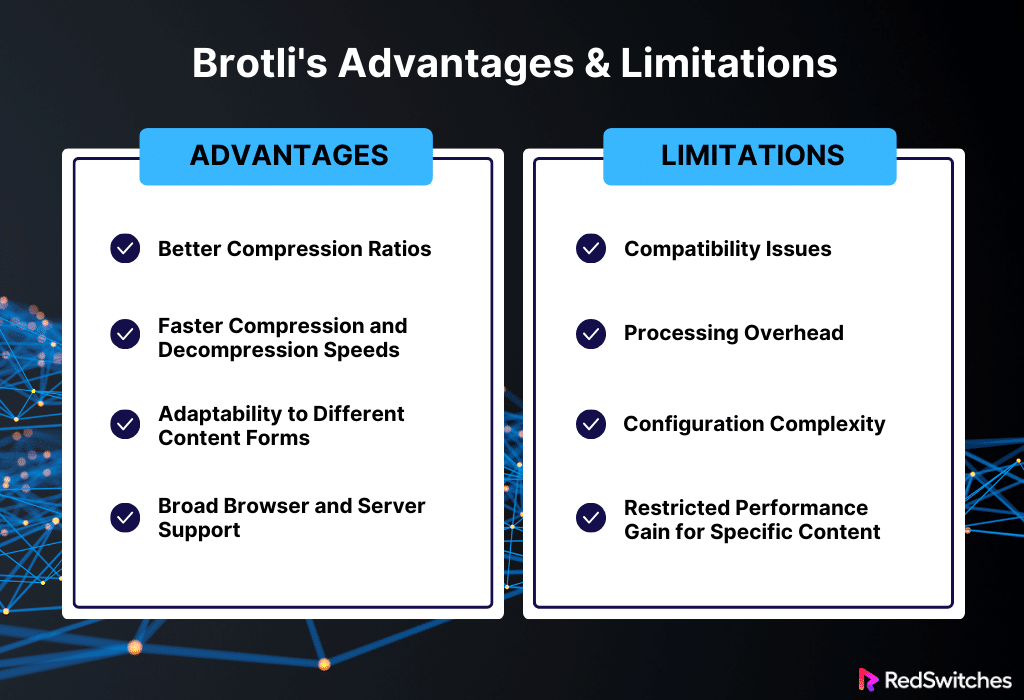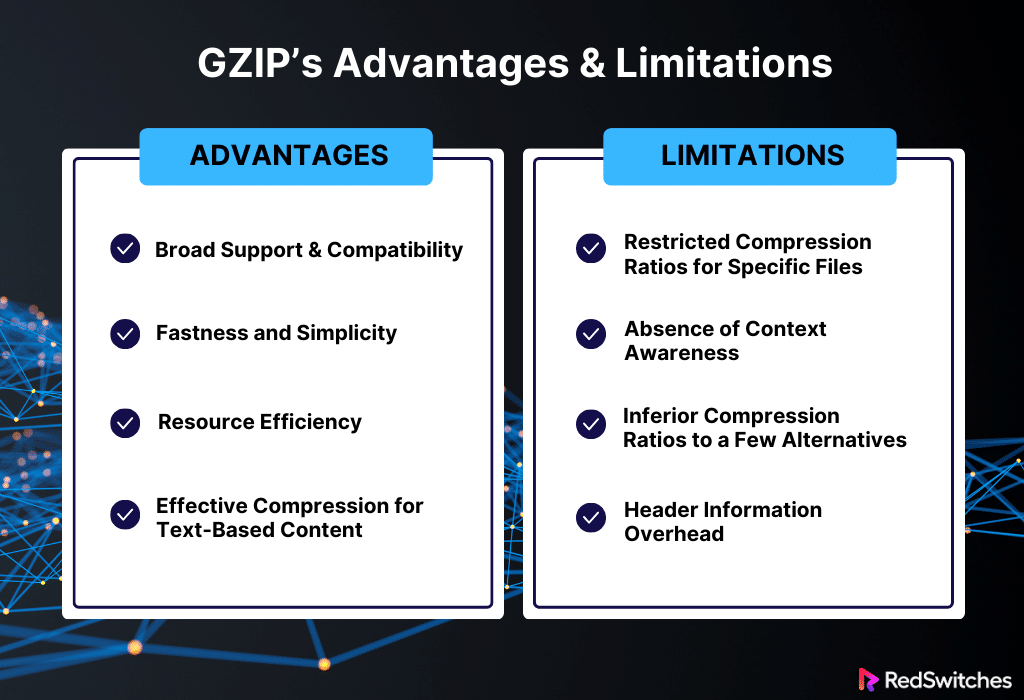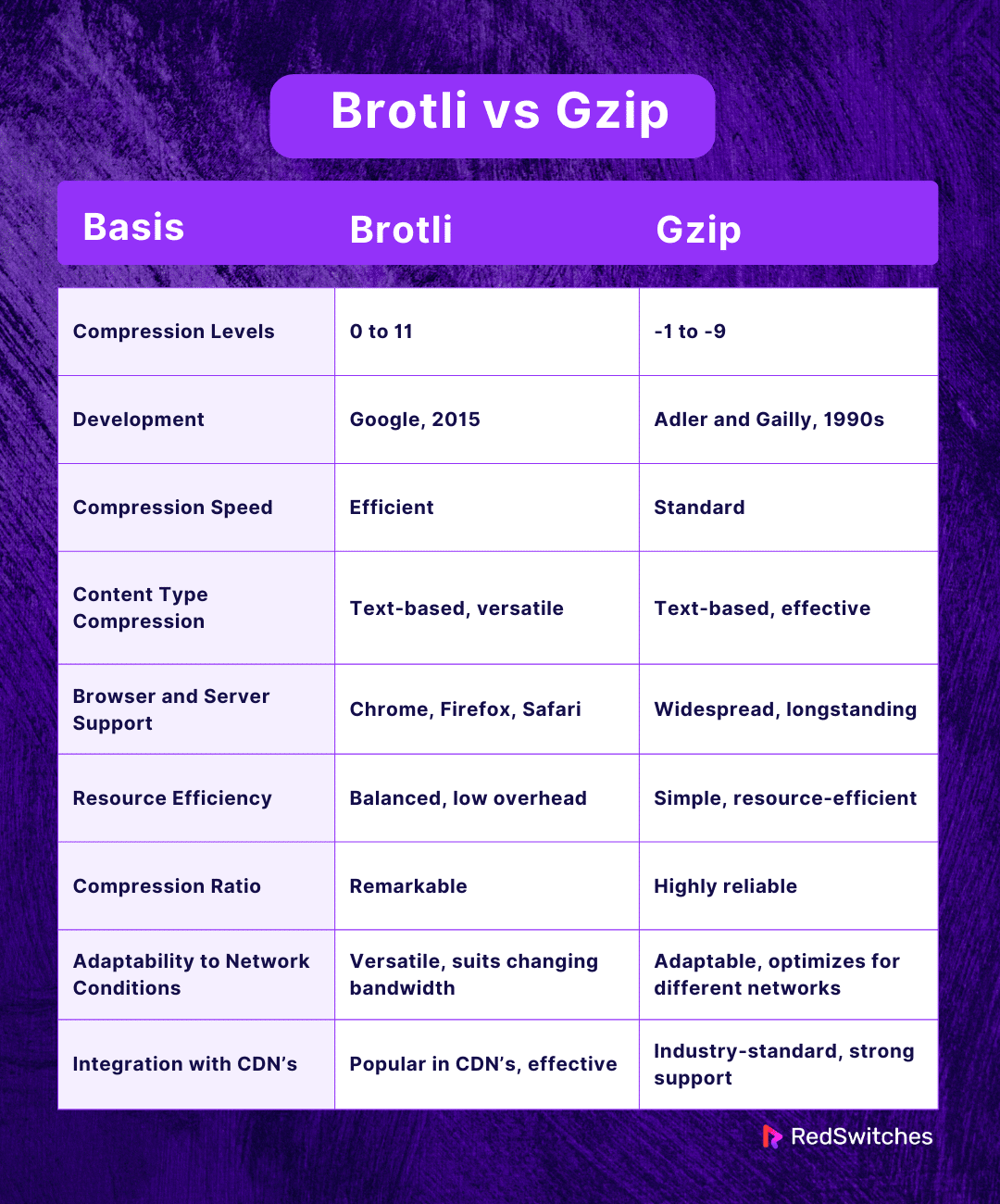Worried about slow website loading times? You’re not alone. In today’s fast-paced world, every second counts, and those extra seconds your website takes to load can send visitors bouncing. Choosing the suitable web compression method as a perfect sidekick for your website’s performance quest can be daunting.
In this blog, we face off Brotli and Gzip, two popular competitors, head-to-head! We’ll break down their 9 key differences, helping you choose the right one for your website. Gzip shrinks files to make websites faster. It’s been around for a long time, and everyone (websites and browsers) knows how to use it, as it’s a classic, reliable option for faster loading.
Meanwhile, Brotli, promises innovation. We will discuss a complete comparison in our gzip vs brotli debate section. As data flows through the digital arena, come along on this journey to uncover the differences between brotli vs gzip web compression. We’ll check out what each is good at, where they fall short, and watch the intense fight for the top spot between these two compression giants.
Table of Contents
- What Is Brotli Compression?
- What Is GZIP Compression?
- Brotli vs GZIP: A Head-to-Head Comparison
- Brotli vs Gzip: Compression Levels
- Brotli vs Gzip: Development
- Brotli vs Gzip: Compression Speed
- Brotli vs Gzip: Content-Type Compression
- Brotli vs Gzip: Browser and Server Support
- Brotli vs Gzip: Resource Efficiency
- Brotli vs Gzip: Compression Ratio
- Brotli vs Gzip: Adaptability to Network Conditions
- Brotli vs Gzip: Integration with Content Delivery Networks (CDNs)
- How to Use Brotli Compression on WordPress
- How to Use GZIP Compression on WordPress
- Is It Worth It to Pay Extra for Website Asset Compression?
- Conclusion
- FAQs
What Is Brotli Compression?
Credits: Freepik
One data compression algorithm is called Brotli. But there’s more to explore; otherwise, there wouldn’t be a reason to delve into it.
Google creates it and offers “lossless” compression under an MIT license. Given that the company frequently leads web technology advancement, it should be no surprise that Brotli strives to take what GZIP does well and provide consumers and websites with an improved experience.
Brotli Compression Algorithm
Google’s compression algorithm, known as Brotli, is a powerful player in the digital world that redefines the effectiveness of data compression on the web. This algorithm, which gets its name from the German word “brot,” which means bread in Switzerland, is the lifesaver for users wanting to leverage quicker load speeds and less bandwidth usage.
Brotli is unique because it balances compression and speed. By using a smart context modeling technique and a more extensive lexicon than its predecessor, Gzip Brotli can recognize and replace repeating patterns more effectively. As a result, files become much smaller, and pages load much faster, which is quite helpful for people browsing the vast internet.
How does it Work?
Brotli compresses data smartly, using algorithms and methods to find and reduce repeated information. In simpler terms, it finds and shrinks repetitive information to make files smaller. Here’s a short explanation of how Brotli compression works:
Dictionary-Based Compression: Brotli recognizes and replaces common patterns in the data by using a predetermined vocabulary of commonly used words and phrases. This dictionary’s reference to recurring sequences aids in more effective data encoding. It has approximately 13,500 words for compressing web data.
Context Modelling: Context Modeling in Brotli involves considering the surroundings of each piece of data when determining what to compress. This context-aware approach allows the system to adapt dynamically to different types of content, resulting in increased compression ratios.
Arithmetic Coding: Brotli employs a range coding method called arithmetic coding in conjunction with a variation of the Lempel-Ziv-Welch algorithm. This technique allows one to express frequently used patterns more compactly by assigning variable-length codes to input data based on their probability of occurrence.
Brotli’s Advantages
The Brotli compression algorithm from Google boasts several advantages, shedding light on its growing popularity in the digital realm. Here are the five key benefits:
Better Compression Ratios: When compared to Gzip, Brotli regularly obtains higher compression ratios. With the help of context modeling, advanced encoding methods, and a more extensive lexicon, Brotli finds and removes redundant material, leading to much-reduced file sizes.
Faster Compression and Decompression Speeds: Brotli maintains competitive compression and decompression speeds, even with its remarkable compression ratios. This efficiency is vital for websites and real-time apps, where fast loading times are critical to a satisfying user experience.
Adaptability to Different Content Forms: Brotli can dynamically adjust to different forms of content because of its context-aware methodology. It is versatile for various applications and content types since it can analyze and compress data effectively, regardless of the data type—text, photos, or other media.
Broad Browser and Server Support: Most contemporary web browsers and servers now support Brotli. Large web servers like Apache and Nginx now come with modules to enable Brotli compression, and major browsers like Chrome, Firefox, and Safari have built-in support for Brotli. This widespread support guarantees that a big user base can benefit from Brotli.
Brotli’s Limitations
Compatibility Issues: Although Brotli has been widely used, particularly by significant browsers and servers, compatibility problems may still occur in some situations. Content compressed by this technique may not work correctly on older browsers or computers that do not support Brotli.
Processing Overhead: Brotli’s compression algorithm can demand more processing resources to achieve higher compression ratios due to its complexity compared to some alternatives. This could be considered for locations or devices with limited resources when reducing computational overhead is essential.
Configuration Complexity: Compared to simpler compression algorithms like Gzip, fine-tuning Brotli compression parameters to achieve the ideal balance between compression ratio and speed might be more complex. Those who prefer simple, off-the-shelf solutions may find the requirement for precise configuration challenging.
Restricted Performance Gain for Specific Content: Text-based content and some media formats are well-suited for compression using Brotli. Nevertheless, the additional compression advantage might be restricted for compressed or highly randomized data, like particular picture and video codecs. The advantages of Brotli might not be as noticeable in these circumstances.
What Is GZIP Compression?
Credits: Freepik
Before moving into the Brotli vs Gzip debate, we will discuss what exactly the GZIP compression algorithm is.
The purpose of the Gzip file format is to compress HTTP material before sending it to a client. It optimizes transmission and minimizes file size using the gzip technique.
File types frequently linked to gzip include:
.gz: This extension indicates that the gzip algorithm has compressed the file.
.tar file, tarball: While not primarily for compression, the tar format is used for archiving multiple files. Gzip can be utilized to compress .tar files.
.tgz, .tar.gz, and .gz file extensions signify a .tar file that has been compressed using gzip.
Gzip compression is valuable for reducing file sizes and improving HTTP content delivery performance.
If you want to know how to fix the “HTTPS Not Secure” message in chrome, here’s our go-to guide.
GZIP Compression Algorithm
Building on the deflate method, which combines LZ77 and Huffman coding techniques, the lossless compression algorithm is known as GZIP. It guarantees that the decompressed data stays similar to the original since it uses a lossless compression technique.
The GZIP compression process has two phases. It starts by locating repeating byte sequences in the data and swapping them out for abbreviated versions. Then, depending on how frequently these condensed sequences occur, a variable number of bits are assigned to them. Rarer sequences are allotted more bits, whereas more frequent sequences receive fewer bits.
This compression process significantly reduces the size of the compressed file compared to the original file.
How does it Work?
The lossless compression algorithm is the foundation of Gzip. The original data is preserved during and after compression; all credit goes to this procedure.
The gzip compression process involves two steps:
- Repeated byte sequences are recognized and represented by a shorter sequence during compression.
- The number of bits allotted to shortened sequences depends on how frequently they occur. A sequence is allotted fewer bits if it occurs frequently. Alternatively, extra bits are allocated if the sequence doesn’t occur frequently.
This process results in the original file being compressed.
GZIP’s Advantages
Let us go through the advantages of GZIP.
Broad Support and Compatibility: Gzip is compatible with many web servers, operating systems, and web browsers. Because of its widespread compatibility, Gzip-compressed files may be easily generated and decompressed on various platforms, making it an adaptable solution for various contexts.
Fastness and Simplicity: Gzip is renowned for being easy to use and apply. Because of the algorithm’s simplicity, systems and applications can easily incorporate it. Furthermore, Gzip balances computational overhead and efficiency by achieving comparatively quick compression and decompression speeds.
Resource Efficiency: Gzip effectively balances resource usage with compression effectiveness. It maintains comparatively modest processing requirements while providing a good compression ratio that reduces large file size. Because of this, it is appropriate in situations where reducing resource consumption is crucial.
Effective Compression for Text-Based Content: Gzip is a highly efficient tool for compressing text-based content, including HTML, CSS, and JavaScript files frequently used in web development. Gzip attains remarkable compression ratios for these kinds of data because it efficiently applies the Deflate algorithm and Huffman coding, resulting in quicker web page loads and less bandwidth usage.
Credits: Freepik
GZIP’s Limitations
Restricted Compression Ratios for Specific File Kinds: Gzip might not achieve the best compression ratios for specific file kinds, particularly those highly randomized or already compressed. Gzip compression might not impact image and video files as much because they frequently employ specialized compression techniques.
Absence of Context Awareness: More recent compression algorithms like Brotli have context-awareness characteristics that Gzip does not. Because it handles every piece of data separately, it could not adjust as well to the unique qualities of the content. Suboptimal compression may arise in situations when context knowledge is essential.
Inferior Compression Ratios to a Few Alternatives: Although Gzip offers respectable compression ratios, it does not perform as well as more sophisticated algorithms like Brotli. Customers who want to save as much space as possible in their files could choose techniques with higher compression ratios.
Header Information Overhead: Gzip compresses the file and includes header information, which may result in extra overhead. This header increases the compressed file’s size slightly, even though it’s essential for decompression. This expense may be taken into account in scenarios when reducing file size is essential.
Here’s our guide for programmers based on Python vs JavaScript: 16 differences between the popular programming languages.
Brotli vs GZIP: A Head-to-Head Comparison
Credits: Freepik
In this section of our core blog, we will comprehensively understand the head-to-head comparison in the Brotili vs Gzip debate.
Brotli vs Gzip: Compression Levels
The first point of difference in the long-lasting Brotli vs Gzip debate is Compression Levels.
Brotli
With the variety of compression settings that Brotli provides, users can customize their compression technique to meet their unique requirements. Brotli offers customers freedom when attempting to balance processing speed and compression efficiency, with a range of 0 to 11, where 0 denotes no compression, and 11 is the maximum compression level. Reduced file sizes are achieved with higher compression settings but may demand more processing power.
GZIP
Multiple compression levels, usually indicated from -1 to -9, are provided by GZIP. Higher compression levels result in more intensive compression, which reduces file sizes but lengthens processing times. Users can choose between minimizing computational overhead and attaining the shortest file size with GZIP’s compression options.
These 16 tips on how to increase your server speed & performance are unmissable and will surely help you a lot to do so!
Brotli vs Gzip: Development
In this section of our Brotli vs Gzip argument, we will discuss the origins and foundations of both compression algorithms.
Brotli
Google created Brotli, a replacement for GZIP that aims to improve compression efficiency and solve some drawbacks. To improve web performance by reaching higher compression ratios without sacrificing decompression speed, Google launched Brotli in late 2013. Because Brotli is open-source, various platforms and browsers have adopted it.
GZIP
GZIP has been around since the early 1990s, giving it a lengthier history. Mark Adler and Jean-loup Gailly created it as a free, open-source substitute for the compressed software. Over time, GZIP has emerged as the industry standard for data compression and is extensively compatible with various web servers and operating systems. Its simplicity and dependability encourage people to keep using it.
Brotli vs Gzip: Compression Speed
Compression Speed is another critical factor in the Brotli vs Gzip debate.
Brotli
Google’s compression algorithm, called Brotli, is renowned for its better compression ratios and frequently produces lower compressed files than Gzip. Nevertheless, compression speed is sacrificed in order to achieve this increased compression efficiency. In comparison to Gzip, the compression rates of Brotli’s algorithm may be slower because it requires more processing power to attain optimal compression.
GZIP
Gzip is a well-known and experienced compression algorithm that emphasizes striking a balance between speed and compression efficiency. Because of its effective compression and comparatively quick processing has been a standard option for compressing online material, including HTML, CSS, and JavaScript.
Gzip is appropriate for various applications where rapid compression and decompression times are crucial due to its emphasis on offering a decent balance between compression speed and efficacy.
Brotli vs Gzip: Content-Type Compression
Brotli
Brotli can effectively compress a variety of content formats, thanks to its sophisticated encoding techniques and contextual awareness. It is particularly good at compressing text-based files, such as those used in web development, such as HTML, CSS, and JavaScript. Because of its flexibility in handling many material kinds, Brotli is a solution that can be used for a wide range of applications.
GZIP
GZIP is especially useful for text-based information compression and has long been the industry standard in web development. It effectively minimizes the size of JavaScript, HTML, and CSS files, which helps speed up web page loading. GZIP’s efficacy may differ for highly compressed or randomized data, such as some image and video formats.
Brotli vs Gzip: Browser and Server Support
In this section, we will understand the browsers and server support for each of the Brotli and Gzip supports. Let’s understand the Browser and Server support in our Botli vs Gzip argument.
Brotli
Many contemporary web browsers now support Brotli. Prominent players like Apple Safari, Mozilla Firefox, and Google Chrome have integrated support for Brotli. Furthermore, the web development community has adopted Brotli compression due to the introduction of modules by well-known web servers like Nginx and Apache.
GZIP
GZIP has been a web compression standard for decades, with widespread support across browsers and servers. Almost all contemporary online browsers support GZIP compression, and most web servers also have this feature. It is a dependable option for guaranteeing compatibility across many systems due to its extensive support.
Check out our complete tutorial on web server vs application server: how to pick the right platform for your operations.
Brotli vs Gzip: Resource Efficiency
Resource efficiency is another crucial element in Brotli vs Gzip argument.
Brotli
Brotli aims to balance resource consumption with compression efficiency. Thanks to its practical encoding algorithms and context modeling, it maintains low processing requirements while attaining excellent compression ratios. For applications and contexts where minimizing processing overhead is a priority, Brotli’s resource efficiency is essential.
GZIP
GZIP is renowned for being resource-efficient and straightforward. Its simple implementation makes it convenient to include in different systems. Although GZIP offers outstanding compression ratios, it may use more CPU power, particularly at higher compression levels. This is something to keep in mind in environments with limited resources.
Brotli vs Gzip: Compression Ratio
Let’s explore the Compression ratio point in our Brotli vs Gzip debate.
Brotli
Known for having remarkable compression ratios, Brotli frequently outperforms GZIP regarding file size reduction. Brotli’s sophisticated encoding methods, such as context modeling and a broader lexicon, help it recognize and more effectively remove redundancy from data. As a result, the compressed files are much smaller, which saves bandwidth and speeds up data transport.
GZIP
GZIP provides high compression ratios, particularly for text-based content. Its compelling combination of the Huffman coding and the Deflate algorithm lowers file sizes, which helps web pages load more quickly. Although GZIP might not attain the same compression ratios as Brotli in specific situations, it is nevertheless a dependable option for striking a balance between processing speed and compression effectiveness.
Brotli vs Gzip: Adaptability to Network Conditions
Which algorithms best suit complex network conditions? Let’s understand the adaptability to network conditions point in the Brotli vs Gzip debate.
Brotli
Brotli is designed to adapt to different network conditions and is suitable for environments with changing bandwidths. Because of its effective compression, data can be transferred more quickly, lessening the effect of network constraints. Because of its versatility, Brotli is especially useful for people with inconsistent internet access.
GZIP
GZIP has been used extensively in web development and is known for its ability to adjust to various network circumstances. Optimizing compression speed to efficiency ratio helps networks with different bandwidths operate better. The versatility of GZIP has played a significant role in its ongoing adoption in a variety of online contexts.
Brotli vs Gzip: Integration with Content Delivery Networks (CDNs)
In our Brotli vs Gzip argument, how both compression techniques fare in integrating CDNs. Let’s discuss.
Brotli
Brotli is becoming increasingly popular, especially in content Delivery Networks (CDNs), where its effective compression is essential to maximizing web content delivery. With the widespread adoption of Brotli support by CDNs, websites may now take advantage of its benefits in lowering file sizes and enhancing overall web performance for a worldwide audience.
GZIP
GZIP has been the industry standard for CDN optimization for years, and many content delivery networks strongly support it. Due to its extensive usage and adaptability to different CDN setups, GZIP is a dependable option for effectively distributing compressed material to users globally. This is how both techniques are differentiated in CDNs in the Brotli vs Gzip debate.
Do you know the difference between CDN and cloud services? Here’s an exclusive article on content delivery network (CDN) vs. cloud services.
Let’s understand the Brotli vs gzip debate through a concise tabular format:
| Basis | Brotli | Gzip |
| Compression Levels | 0 to 11 | -1 to -9 |
| Development | Google, 2015 | Adler and Gailly, 1990s |
| Compression Speed | Efficient | Standard |
| Content Type Compression | Text-based, versatile | Text-based, effective |
| Browser and Server Support | Chrome, Firefox, Safari | Widespread, longstanding |
| Resource Efficiency | Balanced, low overhead | Simple, resource-efficient |
| Compression Ratio | Remarkable | Highly reliable |
| Adaptability to Network Conditions | Versatile, suits changing bandwidth | Adaptable, optimizes for different networks |
| Integration with CDN’s | Popular in CDN’s, effective | Industry-standard, strong support |
How to Use Brotli Compression on WordPress
Credits: Freepik
After learning the Brotli vs Gzip debate through a comprehensive guide, we will understand the steps to use Brotli Compression on WordPress in this section.
By lowering file sizes and speeding uploads, Brotli compression on WordPress can significantly improve the performance of your website. To activate Brotli compression for your WordPress website, follow these steps:
Verify Brotli Support
Ensure your web hosting server supports Brotli before turning on Brotli compression. Although many contemporary servers do, it’s a good idea to double-check. You can search for server specs on your hosting account dashboard or contact your hosting provider.
Upgrade to HTTPS
For security purposes, it is advised to utilize Brotli instead of HTTPS. Ensure HTTPS is enabled and your WordPress website runs with an SSL certificate. You may accomplish this by changing the URL of your WordPress website to “https://” in the Settings > General section.
Update Server Configuration
It might be necessary to access your server’s configuration files. You may need help from your hosting company if you use a shared hosting solution. If you have access to server configurations, you might want to consider the following options:
For Apache server
<IfModule mod_brotli.c>
AddOutputFilterByType BROTLI_COMPRESS text/html text/plain text/xml text/css text/javascript application/javascript application/x-javascript application/xml application/json application/rss+xml application/atom+xml font/truetype font/opentype font/woff
</IfModule>
For Nginx server
brotli on;
brotli_types text/plain text/css application/javascript text/xml application/xml application/xml+rss text/javascript image/x-icon image/vnd.microsoft.icon image/vnd.djvu application/json font/opentype application/x-font-ttf font/eot font/otf image/svg+xml;
WordPress Plugins
You can use WordPress plugins to enable Brotli compression if you don’t feel comfortable making manual server configuration changes. Numerous plugins streamline the procedure and manage the configuration on your behalf. A well-liked choice in this regard is Brotli, as illustrated below:
Brotli: The “Brotli” plugin makes things easier by allowing Brotli compression without requiring configuration by hand. Plugins can be installed and activated from the WordPress Plugin Directory.
Testing and Optimization
To ensure that the Brotli compression is operating correctly, you must test the functionality of your website after turning it on. You may learn more about your website’s compression effectiveness and loading speeds using online tools like GTmetrix or Google PageSpeed Insights.
Monitor Compatibility
Even though Brotli is extensively supported, monitoring how well your website works across different browsers is essential. Although previous versions might not, most modern browsers support Brotli. To guarantee every visitor has a positive experience, regularly review your website’s stats and user reviews.
Frequent Backups
Always make a backup before making any significant adjustments to the setup of your website, including the compression settings. This guarantees you can return to a previous state if problems occur when implementing Brotli compression.
How to Use GZIP Compression on WordPress
By decreasing file sizes and speeding up page loads, implementing GZIP compression on a WordPress website is an easy yet effective way to improve website performance. Here’s how to set up GZIP compression on your WordPress website, step-by-step:
Verify GZIP Support
Before moving on, check if your web hosting server supports GZIP compression. The majority of contemporary servers do. However, it’s best to inquire with your hosting company or review the server specs in your hosting account dashboard.
Update to HTTPS
HTTPS is advised for general security and browser compatibility, even though it is not technically necessary for GZIP compression. If your website does not use HTTPS, you might want to acquire and set up an SSL certificate. To enable safe data transfer, update the URL of your WordPress site to use “https://” under Settings > General.
Server Configuration
You might need access to your server’s configuration files. For help, contact your hosting company if you use shared hosting. If you have access to a server, you might want to consider these options:
Apache Server
Include the subsequent lines in your .htaccess file:
<IfModule mod_deflate.c>
# Compress HTML, CSS, JavaScript, Text, XML, and fonts
AddOutputFilterByType DEFLATE application/javascript
AddOutputFilterByType DEFLATE application/rss+xml
AddOutputFilterByType DEFLATE application/vnd.ms-fontobject
AddOutputFilterByType DEFLATE application/x-font
AddOutputFilterByType DEFLATE application/x-font-opentype
AddOutputFilterByType DEFLATE application/x-font-otf
AddOutputFilterByType DEFLATE application/x-font-truetype
AddOutputFilterByType DEFLATE application/x-font-ttf
AddOutputFilterByType DEFLATE application/x-javascript
AddOutputFilterByType DEFLATE application/xhtml+xml
AddOutputFilterByType DEFLATE application/xml
AddOutputFilterByType DEFLATE font/opentype
AddOutputFilterByType DEFLATE font/otf
AddOutputFilterByType DEFLATE font/ttf
AddOutputFilterByType DEFLATE image/svg+xml
AddOutputFilterByType DEFLATE image/x-icon
AddOutputFilterByType DEFLATE text/css
AddOutputFilterByType DEFLATE text/html
AddOutputFilterByType DEFLATE text/javascript
AddOutputFilterByType DEFLATE text/plain
AddOutputFilterByType DEFLATE text/xml
# Remove browser bugs (only needed for really old browsers)
BrowserMatch ^Mozilla/4 gzip-only-text/html
BrowserMatch ^Mozilla/4\.0[678] no-gzip
BrowserMatch \bMSIE !no-gzip !gzip-only-text/html
Header append Vary User-Agent
</IfModule>
Nginx Server
Add the following lines to your server box configuration:
gzip on;
gzip_disable "msie6";
gzip_vary on;
gzip_proxied any;
gzip_comp_level 6;
gzip_buffers 16 8k;
gzip_http_version 1.1;
gzip_types text/plain text/css application/json application/javascript text/xml application/xml application/xml+rss text/javascript image/svg+xml;
WordPress Plugins
These might make the procedure easier if you’re uncomfortable making manual server configuration changes. You may configure GZIP compression for yourself with several plugins. Several well-liked choices include:
W3 Total Cache
A feature-rich caching plugin with GZIP compression settings is W3 Total Cache. After installing and activating the plugin, select Performance > General Settings and tick the “Enable GZIP Browser Compression” box.
WordPress Super Cache
WordPress Super Cache is another popular caching plugin. Go to Settings > WP Super Cache, select the “Advanced” tab, install and activate the plugin, and tick the box next to “Compress pages so they’re served more quickly to visitors.”
Testing and Optimization
Ensure the GZIP compression is functioning correctly by testing the speed of your website after you’ve enabled it. You may learn more about your website’s compression effectiveness and loading times with GTmetrix and Google PageSpeed Insights tools.
Monitor Compatibility
Even though GZIP is widely supported, regularly check how well your website works across different browsers. Most modern browsers wholly support GZIP; however, it’s necessary to guarantee a seamless experience for every visitor.
Regular Backups
Create a backup before significantly adjusting your website’s setup, including the compression settings. This guarantees you can return to a previous state if problems occur while implementing GZIP compression.
Is It Worth It to Pay Extra for Website Asset Compression?
Credits: Freepik
One of the biggest questions in the user’s mind is whether paying extra bugs for Website asset compression is beneficial. Here, we will discuss the key considerations to help you make a wise decision concerning the Brotli vs Gzip debate.
Type of Website
Asset compression can be pretty helpful if most of the information on your website is static—that is, non-changing files like stylesheets, scripts, and images. However, not as many dynamic websites with ever-changing content may still gain.
Audience and Interface
Asset compression can improve user experience by reducing download times if your website serves a global audience with varied internet connections. A website that loads faster can boost user happiness and engagement among international users, particularly those with slower connections.
Website Performance Objectives
Asset compression can be helpful if your website has certain performance objectives, such as meeting user experience benchmarks or attaining quick page loads. Improved SEO results and decreased bounce rates are frequent outcomes of faster-loading webpages.
Type of Compression
GZIP and Brotli are two popular and efficient free compression programs that are accessible. On the other hand, certain premium compression services could provide more features, improvements, or committed support. Examine if the additional expense is justified by the particular advantages provided.
Security Points to Remember
Asset compression functions effectively with SSL/TLS encrypted (HTTPS) websites. Before applying compression, make sure your website is HTTPs encrypted. This will assist in preserving the security and integrity of the compressed assets throughout transmission.
High-Traffic Websites
With asset compression, websites with significant traffic counts may see more noticeable performance gains. Smaller files can save bandwidth, saving you and your user’s money—especially if you pay by the amount of data transferred.
Conclusion
We’ve explored the details of these big compression tools, i.e. Brotli vs Gzip, in a head-to-head matchup, examining their benefits, drawbacks, and the subtle distinctions that separate them. Although both have excellent compression qualities, Brotli’s innovative strategy stands out because of its higher compression ratios, particularly for text-based content. But GZIP is a practical option for various online situations due to its long history of dependability and broad support.
Consider your project’s requirements and the fine balance between compatibility and efficiency as you work through the compression issue. RedSwitches is a dependable ally if you’re looking for a dedicated servers hosting solution that recognizes the value of optimized data transfer. with a dedication to hosting that is performance-driven.
We’re committed to performance-driven hosting, working seamlessly with your chosen compression method to deliver your online assets swiftly. Join us in unlocking the power of effective compression for unmatched online performance.
FAQs
Q. Brotli vs Gzip: Which is better?
It depends on the context. Gzip is widely supported and efficient, while Brotli often achieves higher compression ratios, making it superior for specific scenarios.
Q. How is Brotli compared to gzip?
Regarding compression ratios, Brotli typically performs better than gzip, especially for text-based information. Still, Gzip is a good option for speed and compatibility in various online settings.
Q. What is the maximum compression of Brotli?
Brotli provides a compression range of 0 to 11, where 11 is the highest possible compression. Lower file sizes are achieved at higher levels, although additional processing power could be needed.
Q. Is Brotli supported by all browsers?
While Brotli has gained significant support, it may not be universally supported by all browsers. Major modern browsers, including Google Chrome, Mozilla Firefox, and Apple Safari, have integrated Brotli support, but some older browsers may not fully support it.
Q. What is the difference between brotli and gzip compression algorithms?
Brotli is a relatively newer compression algorithm developed by Google, known for its superior compression efficiency compared to gzip. It typically results in smaller file sizes and faster load times for websites.
Q. How do I enable gzip compression on my server?
To enable gzip compression, you can typically do so through your server’s configuration settings or by adding specific directives to your .htaccess file, depending on the server software you are using.
Q. How do I enable brotli compression on my server?
Enabling brotli compression generally involves configuring your server to recognize and use the brotli compression algorithm when serving web content. This may require specific server-side setup and configuration changes.
Q. Which compression algorithm is more widely used, brotli or gzip?
As of now, gzip is more widely used and supported across various web servers and browsers. However, brotli adoption is increasing due to its efficiency in compressing web content.
Q. Can I enable both gzip and brotli compression on my server?
Yes, it is possible to enable both gzip and brotli compression on your server. By doing so, you can offer content in both compression formats, allowing browsers that support brotli to benefit from its superior compression while still serving gzip-compressed content to older browsers.
Q. What are the benefits of using gzip and brotli compression for a WordPress website?
Enabling gzip and brotli compression can significantly reduce the size of web assets, leading to faster page load times and improved overall website performance. This can result in better user experience and potentially positively impact search engine rankings.
Q. How do the compression levels of brotli and gzip differ?
Brotli tends to offer higher compression ratios at moderate compression speeds compared to gzip, making it more efficient in reducing the size of web assets with minimal impact on server performance.
Q. Is it better to enable brotli or gzip compression on my server?
It is generally recommended to enable both brotli and gzip compression on your server to cater to a wider range of user devices and browsers. By offering content in both compression formats, you can ensure optimal performance for all visitors to your website.
Q. Is brotli compression enabled by default on most hosting servers?
Brotli is not as widely supported as gzip, and its availability may vary across hosting providers. It may require explicit configuration or choosing a hosting provider that specifically supports brotli compression.
Q. What server-side configuration changes are needed to activate brotli compression?
Enabling brotli compression typically involves making specific configuration changes on the server to recognize and apply the brotli compression algorithm to web content. This may require adjustments in the server’s compression settings and related modules.
